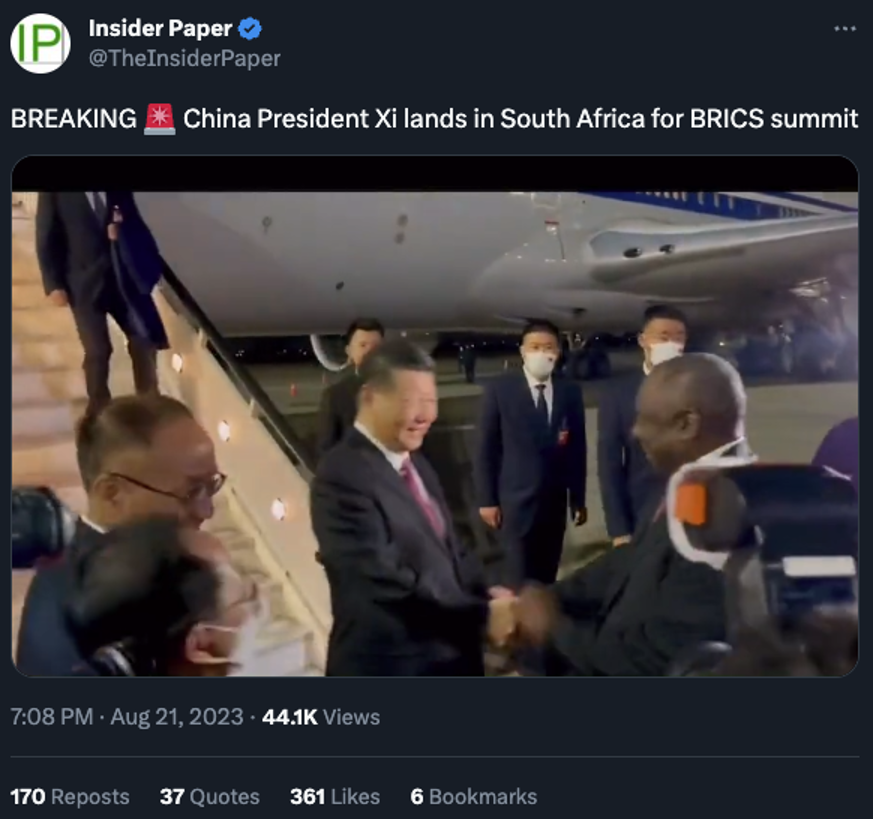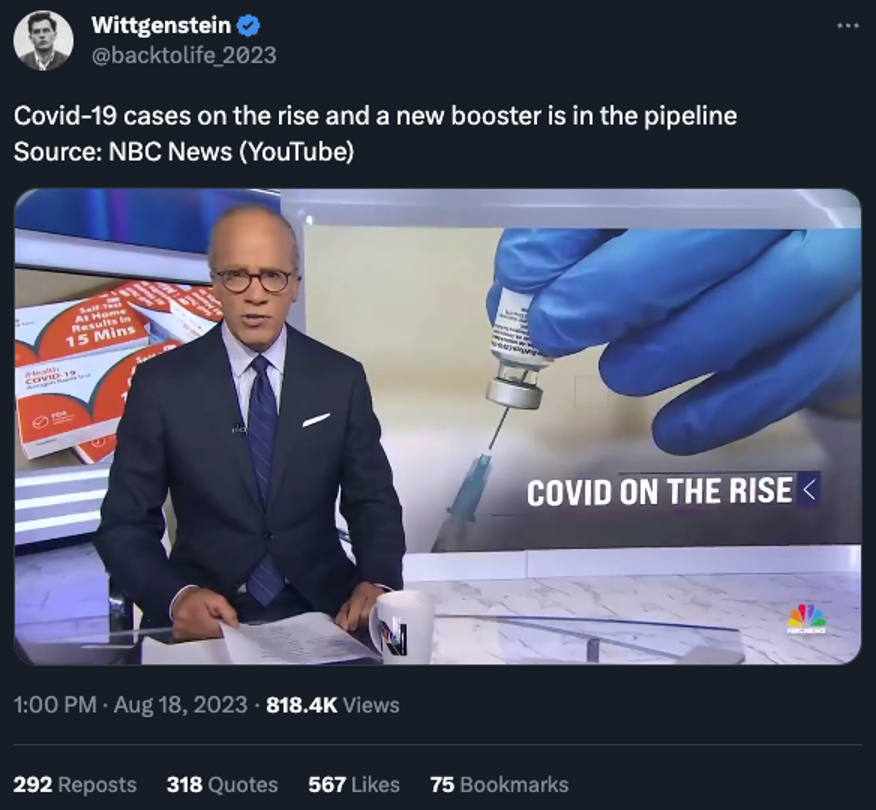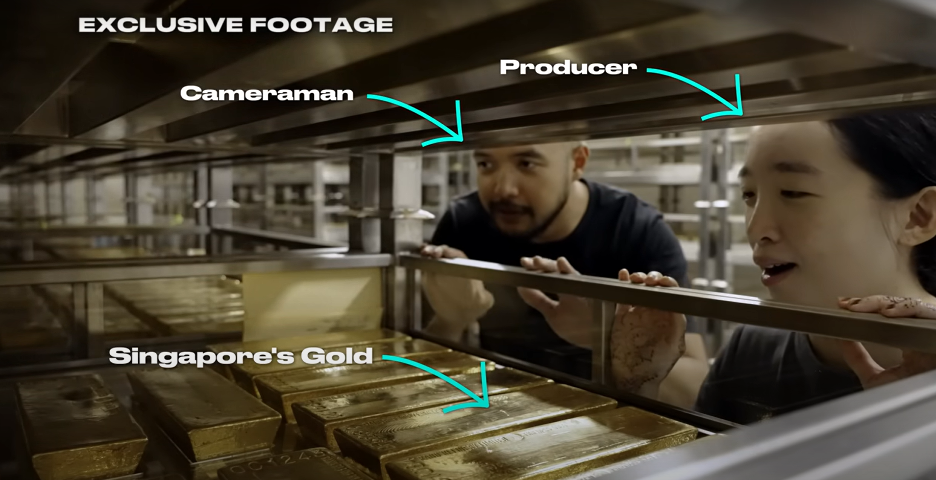Dethroning the Dollar
- [BRICS summit] Nothing like it in over 50 years
- Why COVID again… And why now?
- Here it comes: Fall IPO frenzy
- Auto delinquencies rising
- Singapore’s gold stash.
![]() Nothing Like It in Over 50 Years
Nothing Like It in Over 50 Years
 The conference of the “anti-G7” is underway…
The conference of the “anti-G7” is underway…

That’s Chinese President Xi Jinping being greeted by South African President Cyril Ramaphosa — host for the 2023 summit of BRICS leaders.
Indian Prime Minister Narendra Modi and Brazil’s President Luiz Inacio Lula da Silva arrived with less fanfare. Russian President Vladimir Putin is attending remotely, seeing as South Africa would be obligated to arrest him and turn him over to the International Criminal Court if he set foot there; Foreign Minister Sergey Lavrov is representing Russia in person.
As a reminder, what’s happening this week is shaping up to be “the most significant development in international finance in the last 50 years,” says Paradigm macro maven Jim Rickards.
“It has the potential to displace the U.S. dollar as the leading payment currency and reserve currency from a standing start in just a few years.”
The leaders will tackle two main issues between now and Thursday…
 “The first big issue involves new membership,” says Jim. “The BRICS may be a five-member group, but the actual attendees will more closely resemble a meeting of the United Nations General Assembly.
“The first big issue involves new membership,” says Jim. “The BRICS may be a five-member group, but the actual attendees will more closely resemble a meeting of the United Nations General Assembly.
“Over 67 countries have been invited to attend, including 53 from Africa alone. Among those 67 countries, more than 20 have expressed interest in joining the BRICS, and seven have formally applied for membership. If any new members are admitted at this summit, it is likely the name BRICS+ will be adopted to reflect the expanded membership rather than adding to what may become an awkward string of initials.
“If any new members are admitted, first on this list will be Saudi Arabia. As of now, both Russia and China favor Saudi Arabia for membership. China is the largest purchaser of Saudi Arabian oil, so a formal alliance including both countries makes sense, especially as they and others move forward on a common currency other than the U.S. dollar.
“Also, Russia and Saudi Arabia are two of the three largest oil producers in the world (the other being the U.S.), so including both countries in the same group creates a forum that may be more powerful than OPEC when it comes to setting oil prices.
 “The other major issue is the launch of a new multilateral BRICS currency,” says Jim — one that “might be used to settle trade balances in the short run and then evolve into a reserve currency over a longer period of time.
“The other major issue is the launch of a new multilateral BRICS currency,” says Jim — one that “might be used to settle trade balances in the short run and then evolve into a reserve currency over a longer period of time.
“We know a lot about the potential shape of this new currency based on statements made over the past six months by BRICS leaders themselves as well as their foreign ministers or finance ministers.
“The BRICS currency will not involve the yuan, ruble, rupee or other national currency of the members. Those currencies will continue to exist for domestic consumption and contracts, but they will gradually be replaced by the new BRICS currency for international settlements.
“The value of each unit of BRICS currency will not be tied to another currency or basket. Instead, it will be tied either to a basket of commodities (oil, gold, copper, wheat, iron ore, etc.) or simply to gold.”
An expanded bloc will make this currency more feasible: “The larger the membership in a currency union, the more valuable the currency becomes,” Jim says — simply because the currency can be used in more countries.
“While the outline of the new currency is clear, it’s not clear how much actual progress will be made at this meeting,” Jim allows. “Our expectation is that some announcement will be made about progress toward the new BRICS currency, but it’s premature to announce the currency itself.”
 Point being, “Such an announcement is no less momentous to investors than the actual issue of the currency,” Jim says.
Point being, “Such an announcement is no less momentous to investors than the actual issue of the currency,” Jim says.
“Multilateral organizations with disparate views often take a piecemeal approach to agreements of this kind. What’s important is not that everything be done at once, but that something be done at all. That sets the wheels in motion for the biggest change in the international monetary system since 1971.”
Most of the meetings will be held behind closed doors; the real “tell” will be the final communiqué issued by the leaders as the conference closes Thursday night.
That said, time is running out to act ahead of the announcement. Jim and his team have laid on four trades that will start to move at almost any moment. “I believe the next 30 days could be the best time to trade currencies that we’ve seen in decades,” he says. Follow this link to get started.
![]() Why COVID Again and Why Now?
Why COVID Again and Why Now?
 So before we get to anything about the markets today, we need to talk about new COVID lockdowns — which would upend markets and the economy in ways we can’t yet anticipate.
So before we get to anything about the markets today, we need to talk about new COVID lockdowns — which would upend markets and the economy in ways we can’t yet anticipate.
No, this has nothing to do with anything being claimed on Infowars. We’re just following the breadcrumbs here.
In case you haven’t heard, there’s a new COVID variant called “Eris”... and mainstream media are slowly ramping up the fear porn again.

All the tropes from three years ago are re-emerging: Articles last weekend in the British and German press asserted that the “Barbenheimer” phenomenon is fueling a new outbreak of “cases.” As the story goes, people are finally back in movie theaters — and again spreading the dreaded germ in enclosed spaces.
The Biden administration is urging Americans to get new boosters that aren’t even available yet. Meanwhile, masks are now required at the Lionsgate movie studio (office workers still have to show up despite the Hollywood strike) and at the campus of Morris Brown College in Atlanta.
➢ This just in: The Drudge Report is linking to an Infowars article headlined, “It’s Really Happening: Mask Mandates, Contact Tracing RE-IMPLEMENTED At Colleges, Offices.” Matt Drudge — who took a mainstream turn in recent years — doesn’t routinely send traffic to Infowars nowadays; in fact I can’t remember the last time. Something significant is afoot…
 In the meantime, today’s market action is a snooze: After staging a modest rally and ending yesterday juuust shy of 4,400… the S&P 500 has retreated five points to 4,395. The Dow is down a bit, the Nasdaq up a bit.
In the meantime, today’s market action is a snooze: After staging a modest rally and ending yesterday juuust shy of 4,400… the S&P 500 has retreated five points to 4,395. The Dow is down a bit, the Nasdaq up a bit.
Gold remains stuck below $1,900 but silver did hoist itself past $23 yesterday and that move is holding today at $23.28. Crude is down a quarter to $80.45 and Bitcoin is still a shade below $26,000.
The big economic number of the day is existing home sales — down 2.2% in July, even more moribund than Wall Street economists were expecting. Then again, what else can you expect with mortgage rates at 20-plus year highs and no one holding a low-rate mortgage willing to sell?
Inventory remains tight at 3.3 months’ worth of supply and the average price remains elevated at $406,700.
![]() Here It Comes: Fall IPO Frenzy
Here It Comes: Fall IPO Frenzy
 While U.S. stocks are in the summer doldrums, one niche of the market is showing signs of life — IPOs.
While U.S. stocks are in the summer doldrums, one niche of the market is showing signs of life — IPOs.
The British chipmaker Arm Ltd. made it official yesterday: It will go public on the Nasdaq next month. That’s on the heels of a Bloomberg story last week that the grocery delivery firm Instacart plans to go public by the end of September.
“This is a good sign that the IPO market is opening up and new shares are becoming available for investors,” says Paradigm’s retirement authority Zach Scheidt.
That is, it’s a bullish sign for the stock market overall. But for everyday folks who’d like to buy these companies at the IPO price, forget it.
“Most high-profile IPOs like this are managed by large investment firms,” Zach points out — in the case of Instacart, it’s Goldman Sachs and JPMorgan Chase. “That means their best customers will be given preferential treatment when it comes to who gets these shares at an attractive price.
“Back when I was a hedge fund manager, we did a lot of business with the largest investment banks. And that gave us access to special deals like this. But the average retail investor can't buy shares of IPO stocks until after the stock starts trading in the open market — often at a much higher price.
 “Each of these IPO transactions generates millions of dollars in profit for the leading investment banks and a handful of other tier-two firms,” Zach says.
“Each of these IPO transactions generates millions of dollars in profit for the leading investment banks and a handful of other tier-two firms,” Zach says.
“As the IPO market picks back up, these firms will rake in big profits with very little effort, which makes now a great time to invest in some of Wall Street's largest banks.
“In other words, buying large investment bank stocks gives you a backdoor way to profit from the hottest IPOs on deck over the next several months.”
![]() Auto Delinquencies Rising
Auto Delinquencies Rising
 Uh-oh: Borrowers with poor credit scores are missing car payments at the highest clip since… 2008.
Uh-oh: Borrowers with poor credit scores are missing car payments at the highest clip since… 2008.
That’s according to a recent report from analysts at S&P Global, who call the data “ominous” Among subprime auto borrowers, 5.37% are now 60 days or more in arrears. Little wonder, though, when the average new car loan carries a monthly payment over $750.
And at a time when unemployment is still near 50-year lows: “Usually you get the default spikes when unemployment spikes — it’s the biggest correlation in consumer credit,” says Clayton Triick of Angel Oak Capital Advisors. “To see them go up that much while unemployment is still low is not typical,” he tells The Wall Street Journal.
It can only get worse from here. As we mentioned again yesterday, federal student loan payments resume in October. The credit-reporting firm TransUnion says more than one-third of consumers with student loans took on a new car loan during the pandemic payment holiday.
On the other hand, if new lockdowns are on the way, maybe the holiday will resume? Can’t rule anything out at the rate everything’s going…
![]() Golden Eye Candy, Singapore Edition
Golden Eye Candy, Singapore Edition
 “We could tell you where it is, but then we’d have to kill you.”
“We could tell you where it is, but then we’d have to kill you.”
A lucky camera crew from the Singaporean news channel CNA recently got a glimpse at the gold reserve of Singapore’s central bank.
Its location is a closely guarded secret. In a recent documentary called Singapore Reserves Revealed, CNA personnel were allowed inside — but only after giving up their phones and agreeing to be blindfolded before they were transported there.
 You’d be oohing and aahing, too, right? [CNA/YouTube screengrab]
You’d be oohing and aahing, too, right? [CNA/YouTube screengrab]
See that tray there? Every one of them holds up to 20 gold bars, each bar worth nearly $800,000.
Singapore’s gold stash isn’t especially big — but it’s growing fast. By official figures it’s 153.7 metric tons — the 27th largest in the world, according to the World Gold Council. Then again, the Monetary Authority of Singapore claims the total is substantially higher — 222 metric tons.
Whatever the size, Singapore started accumulating early — over 50 years ago, when the price was still $40 an ounce. Well played.
Gee, imagine a TV crew getting access to the U.S. gold depository at Fort Knox.
The last time members of Congress were able to inspect it in person was… 1974. And that was basically a photo op. According to the folks from the Sound Money Defense League, “the last somewhat credible examination of Fort Knox's gold was in 1953.”
In the meantime, if you want to gawk at the gold, here’s the link to the documentary. Enjoy.
Best regards,

Dave Gonigam
Managing editor, Paradigm Pressroom's 5 Bullets










